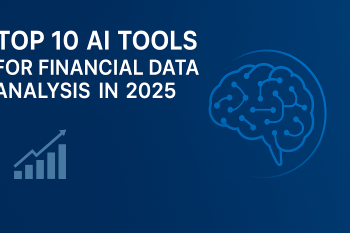
🚀 Introduction
The days of manually reading dozens of balance sheets are over.
In 2025, tools like ChatGPT have become essential assistants for investors — helping to analyze financial data, identify trends, and generate insights faster than ever before.
But how exactly can you use ChatGPT for real stock market research?
In this step-by-step guide, we’ll show you how to turn ChatGPT into your personal financial analyst — using prompts, data inputs, and smart plugins to uncover actionable investment opportunities.
🧠 Why Use ChatGPT for Market Research?
ChatGPT doesn’t just summarize text — it analyzes, compares, and interprets data.
By feeding it structured financial information, you can:
- 🧾 Summarize earnings reports in seconds.
- 📊 Compare company performance across sectors.
- 🧩 Generate valuation models like DCF or P/E analysis.
- 🔍 Identify sentiment in financial news.
- ⚙️ Automate watchlist analysis for multiple tickers.
🪜 Step-by-Step: How to Use ChatGPT for Stock Research
Step 1: Choose the Right ChatGPT Version or Plugin
For stock market research, use ChatGPT Pro (GPT-4 or GPT-5) or tools like Perplexity AI for real-time data access.
Plugins and extensions that can enhance your research include:
- FinanceData or AlphaQuery API → access live stock data
- ChatGPT Code Interpreter (Python mode) → run calculations directly
- Browser plugin → fetch the latest market news
Step 2: Collect and Prepare Data
Before asking ChatGPT to “analyze Apple,” provide it with structured data.
You can paste summaries from:
- Yahoo Finance
- MarketWatch
- TradingView
- Company earnings transcripts
Example Prompt:
“Here are Apple’s last 4 quarters of earnings data. Can you summarize trends in revenue, margins, and EPS growth?”
Step 3: Ask for Financial Analysis
Once data is loaded, you can ask ChatGPT to perform quantitative and qualitative assessments.
Example Prompts:
- “Compare Tesla’s revenue growth and profitability against NVIDIA.”
- “What valuation multiple is justified for a company with 40% annual EPS growth?”
- “Summarize the financial health of Microsoft based on this data.”
ChatGPT will identify patterns and generate analyst-style summaries.
Step 4: Build Investment Theses
Ask ChatGPT to simulate how professional analysts think.
Example Prompt:
“Based on these financial metrics and market conditions, create a bullish and bearish thesis for Alphabet stock.”
This approach helps you see multiple scenarios before making decisions.
Step 5: Automate Watchlists and Alerts
By combining ChatGPT with spreadsheet tools like Google Sheets + API connectors, you can automate watchlists:
- Auto-fetch ticker data
- Ask GPT to “flag undervalued AI stocks”
- Get summaries emailed or logged daily
This transforms ChatGPT into a real-time portfolio assistant.
💡 Advanced Use: Combining ChatGPT with AI Data Tools
For deeper research, pair ChatGPT with dedicated AI finance platforms, such as:
- FinChat → analyzes earnings transcripts and 10-Ks.
- Koyfin AI → offers financial visualization powered by GPT.
- AlphaSense → provides institutional-grade market intelligence.
Together, these tools provide ChatGPT with cleaner inputs — improving accuracy and insight quality.
🧩 Example Workflow
- Collect raw data from Yahoo Finance.
- Paste summaries into ChatGPT.
- Ask for financial trend analysis.
- Request DCF-style valuation or multiples comparison.
- Generate a final investment summary.
Result: a mini analyst report in less than 5 minutes.
⚠️ Important: Limitations and Bias
Even though ChatGPT is powerful, it has no real-time market data access (unless integrated with plugins).
Always:
- Cross-check financial data sources.
- Avoid making direct trades based solely on AI summaries.
- Treat outputs as decision support, not financial advice.
📚 Related Articles
📘 Step-by-Step Guide: Using AI to Analyze Company Financials
📘 Top 10 AI Tools for Financial Data Analysis in 2025
📘 How We Use ChatGPT and AI Tools for Real Market Insights
🧭 Conclusion
In 2025, ChatGPT has become one of the most valuable companions for investors.
By combining natural language understanding with financial modeling capabilities, it enables faster, data-driven decisions — without the noise or bias of social media speculation.
The best investors won’t replace themselves with AI — they’ll learn to collaborate with it.